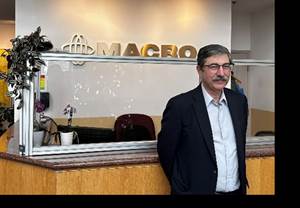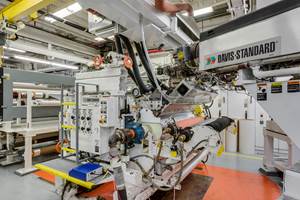Genpak Pioneers in PET Foam Sheet
Soon after Genpak LLC launched its line of CPET trays for commercial baking in the early 1990s, the firm chose foamed PET as its next R&D target.
Soon after Genpak LLC launched its line of CPET trays for commercial baking in the early 1990s, the firm chose foamed PET as its next R&D target. It was a logical goal for a company that was already a market leader in foamed polystyrene clamshells. Genpak, based in Glens Falls, N.Y., saw foam as a potential means of lowering the cost of CPET trays. That view proved prophetic in 1993, when a competitor was the first to market with a foamed PET baking tray. That product from Ultra Pac Inc. in Rogers, Minn., was the first commercial use of foamed PET sheet in North America.
For the next three years, Genpak worked with Du Pont, Shell Chemical, Mossi & Ghisolfi in Italy and Eastman Chemical, in R&D on PET foam. In 1996, Genpak introduced its own foamed PET tray, trademarked PET+. Genpak’s baking trays had half the density of Ultra Pac’s foamed trays—0.15 vs. 0.35 g/cc, notes Genpak R&D manager Walter Harfmann—though both products used high-I.V. PETlite resin from Shell Chemical Co. in Houston. (Shell’s PET business was recently sold to Mossi & Ghisolfi.)
Genpak set up a large, dedicated tandem foam-sheet extrusion line at its newest plant in Scottsburg, Ind. The line incorporated 4.5-in. and 6-in. extruders from Battenfeld Gloucester Engineering, Gloucester, Mass.
By 1996, Ultra Pac had discontinued its pioneering foamed PET product because its process created excessive scrap. (In 1998, Ultra Pac was acquired by Ivex Packaging Corp. of Linconshire, Ill.) Although Genpak had a later start in the infant process of foaming PET, its early trials focused on developing a cost-effective process, based on heptane as a blowing agent. While butane, nitrogen, CO2 and other common gases have also been used to foam PET, Genpak found that their high vapor pressure at the die caused quality problems. Undesirable “corrugation” of the sheet occurred when bubbles expanded so rapidly that they folded into themselves.
Genpak’s Harfmann looked for a gas that would have a vapor pressure at PET’s foaming temperature (450-480 F) similar to that of butane at PS foaming temperature (280 F). Heptane fit the bill, and Genpak patented its use in PET foam. Heptane is readily available and inexpensive.
Repelletizing scrap
Genpak also developed a proprietary system for repelletizing foam-sheet scrap left over after thermoforming, which typically runs as high as 55% of production by weight. The patent-pending process restored the I.V. of the sheet trim, which dropped to around 0.95 from the starting level of 1.05 for Shell’s material. In 1999, Shell stopped producing the high-I.V. resin (for which Genpak was the only customer), and Genpak switched to Eastapak PET homopolymer from Eastman Chemical Co., Kingsport, Tenn. That resin’s starting I.V. was only 0.80, but Eastman supplies a polyolefin additive, E3031-92AA, which raises the melt strength and I.V. in the foaming extruder. The additive attaches itself to the ends of PET molecules, forming “pseudo star molecules” by adding length and branches, says Eastman senior technical-service representative Gary Boone. Genpak says the additive also helps cut scrap levels. With Eastman’s resin and additive, Genpak’s repelletizing process raises the I.V. to 1.2-1.4.
Eastman’s additive system also allows Genpak to create new foams with even lower density, some as low as 0.05 g/cc. Though that is too low for baking trays, Genpak is exploring new potential in specialized automotive and electronics applications for such foams’ high insulation value. Genpak is now building a second PET foam line at its plant in Lancaster, S.C., near its product development and R&D facility. This will allow Genpak to make and ship commercial-scale test runs of its latest—and lightest—polyester foams.
Genpak’s Harfmann is developing PET foams with ever-lower density—down to 0.05 g/cc—to open up new applications in automotive and electronics.
Related Content
Macro Names Anzini Tech Sales Manages for Southeast
Has worked in technical roles for leading processing companies in his career of 40+ years.
Read MorePTi Makes Changes in Leadership Structure
Moves aimed at bolstering the future of the sheet extrusion manufacturer.
Read MoreGreen’s the Theme in Extrusion/Compounding
The drive toward circular economy is requiring processors to make more use of PCR. Machine builders at K—across all extrusion processes—will be highlighting innovations to help them do just that.
Read MoreDavis-Standard to be Systems Integrator for Novel EDI Flat Die
Die uses motorized lip-adjustment, said to be three to five times faster than heated-bolt adjustments.
Read MoreRead Next
How Polymer Melts in Single-Screw Extruders
Understanding how polymer melts in a single-screw extruder could help you optimize your screw design to eliminate defect-causing solid polymer fragments.
Read MoreProcessor Turns to AI to Help Keep Machines Humming
At captive processor McConkey, a new generation of artificial intelligence models, highlighted by ChatGPT, is helping it wade through the shortage of skilled labor and keep its production lines churning out good parts.
Read More























